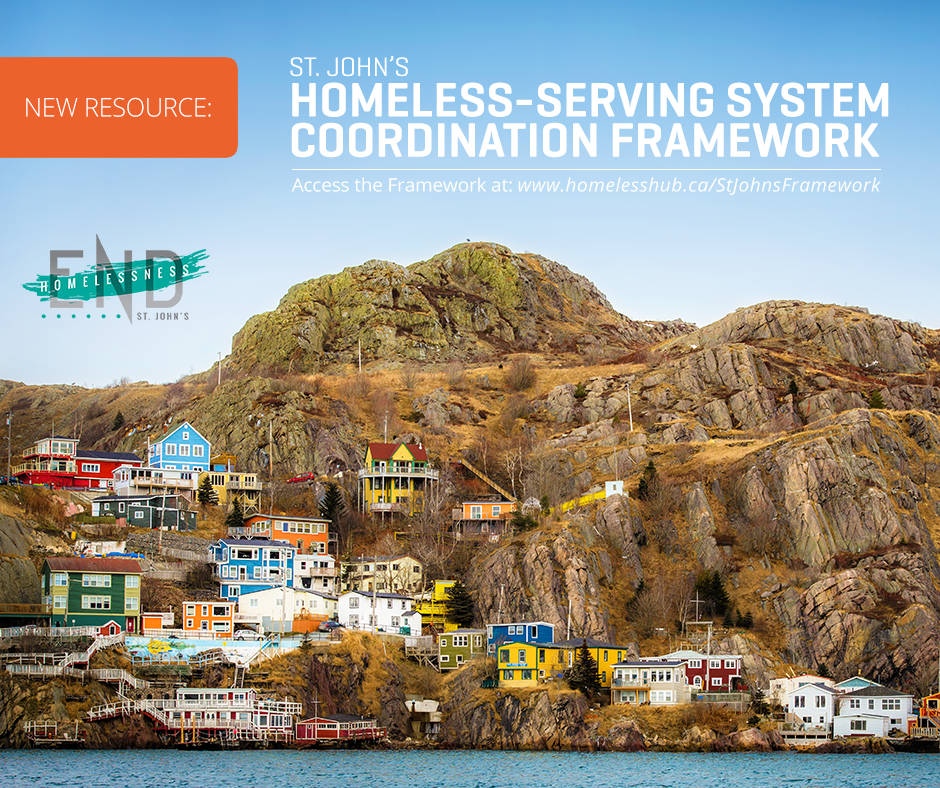As communities embark on implementing respective Plans to End Homelessness and transitions to Housing First, they are confronted with a complex and at times baffling array of services they have to discern, disentangle and weave together into coordinated homeless-serving systems. At times, the work of system mapping, planning and coordination seems straightforward and other times impossible as diverse agendas, services approaches, language and expectations surface. Yet, the process of revisioning the local system response to homelessness grounded in Housing First is essential to successful Plan implementation, and ultimately ending homelessness.
The St. John’s, Newfoundland & Labrador Experience
The Plan to End Homelessness in St. John’s (2014-2019), led by End Homelessness St. John’s (EHSJ), prioritizes the development of a systems approach grounded in Housing First where diverse services are organized and delivered in a coordinated manner to advance common community priorities. The purposeful, design and management of St. John’s homeless-serving system is critical to meeting the community’s objective of ending homelessness.
To this end, diverse community engagement processes were undertaken by EHSJ with the technical assistance of Dr. Alina Turner (Turner Research & Strategy) and the Canadian Observatory on Homelessness (COH) to develop a System Coordination Framework. These included two large community forums, stakeholder interviews and focus groups, including consultations with individuals with lived experience, from November 2015 to May 2016.
The resulting System Coordination Framework approved by EHSJ’s Board in May 2016 provides the community with direction on several key elements:
- Common homeless-serving system processes, including Coordinated Access and acuity assessment, program matching, eligibility and prioritization criteria.
- System mapping to discern the homeless-serving system's structure and program components.
- Performance management and quality assurance standards in alignment with data collection, management and reporting through shared information systems.
- Capacity building needs and resources to deliver training and transition support to diverse services for successful Plan implementation.
Key Directions
Significant decisions were made by community stakeholders over the course of the Framework’s development. Some of the most pertinent actions are surmised below.
- EHSJ will add a System Planner position to lead the implementation of the System Planning Framework. The System Planner would provide supports the overall CA process by developing protocols and processes and ensuring effective and efficient operations of the model.
- A Coordinated Access (CA) model with multiple locations throughout the community will be implemented using the same assessment form, targeting tools, and referral processes with EHSJ playing a key coordinating role supported by a System Planner dedicated position.
- The Vulnerability Assessment Tool (VAT) was adopted as the coordinated assessment tool for the St. John’s CA process. Future adaptations to families and youth of the VAT will be implemented as the Canadian Observatory rolls these out.
- A designated phone line accessible 24 hours a day, 7 days per week will be explored facilitate information and referrals using a standard Referral Guide. This service can be used to screen clients for program eligibility to facilitate program matching pending resources and capacity.
- A Complex Needs Working Group is being struck to address the needs of complex clients with high acuity scores and coordinate care among provides and public systems.
- To enhance integration among homeless-serving agencies and public systems, a Systems Coordination Table is being convened comprising of high-level decision makers that can play key roles in facilitating access to system resources for participants, and support the removal of system barriers for vulnerable populations.
- A formalized Lived Experience Council is being launched to provide meaningful input into the measures outlined in the System Coordination Framework and the Plan in general.
- A provincial HMIS aligned with the direction of the System Coordination Framework is being explored, while locally, HIFIS (the Homeless Families & Individuals Information System) is being adapted to support the CA process.
- System and program-level performance measures and standards of practice have beend developed and will be refined over the course of the next 12 months with support from a dedicated Performance Management Planner.
- A comprehensive slate of capacity building, technical assistance and training opportunities is being launched to support the transition long term.
It is our hope that other communities will leverage our learnings and adapt our process where useful. We are making all related documentation available to the broader community practice with the support of the Canadian Observatory on Homelessness (COH) and look forward to learning from the experience of our colleagues across the country and beyond.


